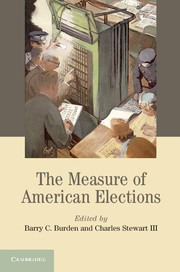Book contents
- Frontmatter
- Contents
- List of figures
- List of tables
- List of contributors
- Acknowledgments
- 1 Introduction to the Measure of American Elections
- 2 Registration and Voting: A View from the Top
- 3 Voter Registration: The Process and Quality of Lists
- 4 Provisional Ballots
- 5 Mail Ballots in the United States: Policy Choice and Administrative Challenges
- 6 Voting from Abroad: Evaluating UOCAVA Voting
- 7 Polling Place Practices and the Voting Experience
- 8 Disability and Election Policies and Practices
- 9 The Performance of Election Machines and the Decline of Residual Votes in the United States
- 10 Voter Confidence as a Metric of Election Performance
- 11 Election Data Transparency
- Appendix
- References
- Index
8 - Disability and Election Policies and Practices
Published online by Cambridge University Press: 05 August 2014
- Frontmatter
- Contents
- List of figures
- List of tables
- List of contributors
- Acknowledgments
- 1 Introduction to the Measure of American Elections
- 2 Registration and Voting: A View from the Top
- 3 Voter Registration: The Process and Quality of Lists
- 4 Provisional Ballots
- 5 Mail Ballots in the United States: Policy Choice and Administrative Challenges
- 6 Voting from Abroad: Evaluating UOCAVA Voting
- 7 Polling Place Practices and the Voting Experience
- 8 Disability and Election Policies and Practices
- 9 The Performance of Election Machines and the Decline of Residual Votes in the United States
- 10 Voter Confidence as a Metric of Election Performance
- 11 Election Data Transparency
- Appendix
- References
- Index
Summary
People with disabilities often face extra difficulties participating in elections. Individuals with mobility impairments, for example, may have difficulty getting to a polling place, getting inside a polling place, and using the voting equipment. People who are blind or have limited vision may have similar problems, particularly with regard to seeing the ballot and registering a choice. People with limited manual dexterity may have problems filling out a ballot or otherwise operating voting equipment, and people with cognitive impairments may have difficulty reading the ballot or understanding how to vote.
This is an important issue for American elections, in part because of the large number of people with disabilities who are eligible to vote and the likely growth in this number as the population ages. Between 35 and 46 million voting-age people with disabilities live in the United States, making them one of the largest minority groups in the country. Over the past few decades, the disability rights movement has achieved many political gains, such as the passage of the Americans with Disabilities Act (ADA) in 1990. These gains have occurred despite evidence that people with disabilities are generally less likely than those without disabilities to vote or engage in other forms of political action.
- Type
- Chapter
- Information
- The Measure of American Elections , pp. 188 - 222Publisher: Cambridge University PressPrint publication year: 2014
- 10
- Cited by

